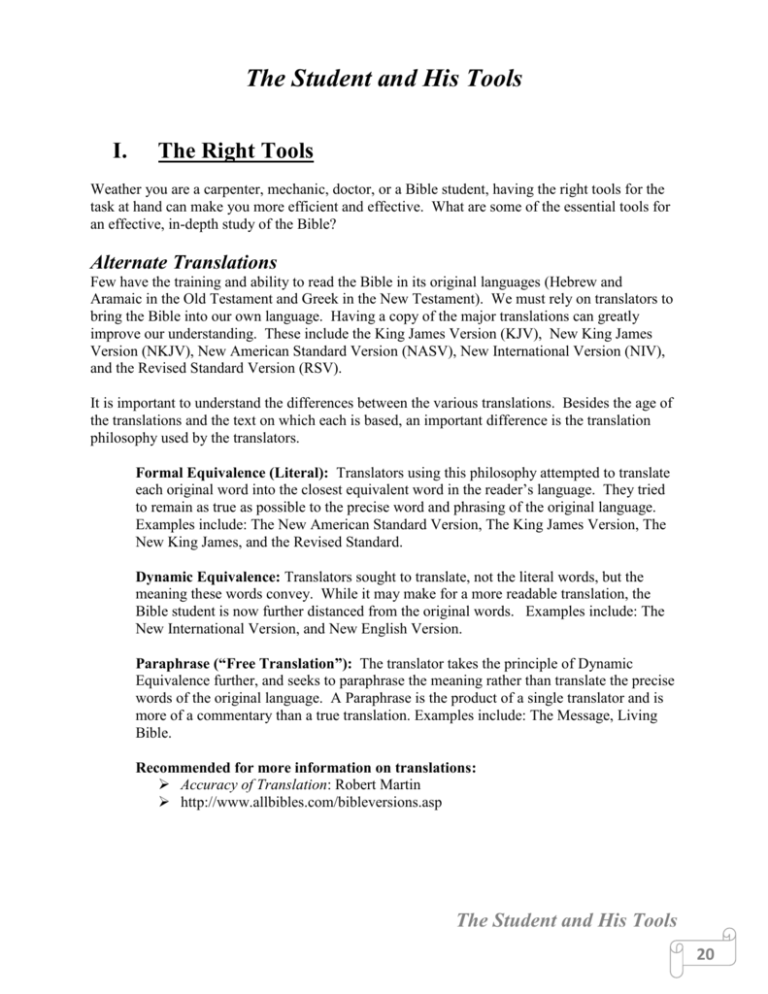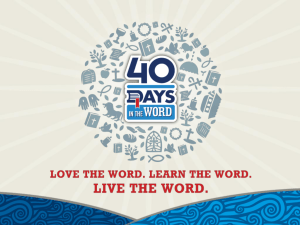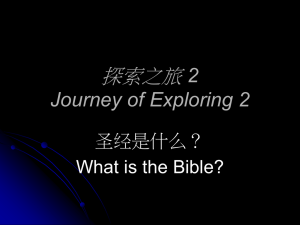File - The Christian Researcher
advertisement

The Student and His Tools I. The Right Tools Weather you are a carpenter, mechanic, doctor, or a Bible student, having the right tools for the task at hand can make you more efficient and effective. What are some of the essential tools for an effective, in-depth study of the Bible? Alternate Translations Few have the training and ability to read the Bible in its original languages (Hebrew and Aramaic in the Old Testament and Greek in the New Testament). We must rely on translators to bring the Bible into our own language. Having a copy of the major translations can greatly improve our understanding. These include the King James Version (KJV), New King James Version (NKJV), New American Standard Version (NASV), New International Version (NIV), and the Revised Standard Version (RSV). It is important to understand the differences between the various translations. Besides the age of the translations and the text on which each is based, an important difference is the translation philosophy used by the translators. Formal Equivalence (Literal): Translators using this philosophy attempted to translate each original word into the closest equivalent word in the reader’s language. They tried to remain as true as possible to the precise word and phrasing of the original language. Examples include: The New American Standard Version, The King James Version, The New King James, and the Revised Standard. Dynamic Equivalence: Translators sought to translate, not the literal words, but the meaning these words convey. While it may make for a more readable translation, the Bible student is now further distanced from the original words. Examples include: The New International Version, and New English Version. Paraphrase (“Free Translation”): The translator takes the principle of Dynamic Equivalence further, and seeks to paraphrase the meaning rather than translate the precise words of the original language. A Paraphrase is the product of a single translator and is more of a commentary than a true translation. Examples include: The Message, Living Bible. Recommended for more information on translations: Accuracy of Translation: Robert Martin http://www.allbibles.com/bibleversions.asp The Student and His Tools 20 Concordances An exhaustive concordance is an alphabetical index of every word in the Bible. A concordance will list each occurrence of the word and usually includes a portion of the verse in which the word appears. A concordance can help you locate a certain verse, identify other verses which use the same word, and begin to define biblical words. There are two basic types of concordances: 1) One indexes entries by the original language: New Englishman’s Hebrew Concordance New Englishman’s Greek Concordance 2) The other indexes entries by English or the receptor language: Strong’s Exhaustive Concordance Young’s Analytical Concordance to the Bible English concordances, like Strong’s and Young’s, do have some limitations. Each entry lists only passages that contain the same English word. However, sometimes a Greek or Hebrew word is translated into several different English words. An English concordance will not show you passages where the original word may appear elsewhere in the Bible as a different English word? Excerpt from Strong’s Although Strong’s does not identify the original word, it does give you a numeric key following each verse which makes it very easy to locate the original word and its full definition in a lexicon. For example, the word “study” is given the numeric key 4704. A Greek concordance allows you want to find every occurrence of the original word regardless of the English Excerpt from Englishman’s Concordance word it is translated into. For example, according to the New Englishman’s Greek Concordance, the original Greek work which is translated “study” in the KJV of 2 Tim. 2:15 appears eleven times in the New Testament and is translated by several English words and phrases. By seeing how the original word is used in other passages, you can get a better understanding of a word’s meaning. The Student and His Tools 21 Greek Dictionaries or Lexicons Because the words of the New Testament cannot be thoroughly defined by a concordance, nor properly defined by a contemporary English dictionary, one must consult a Greek dictionary, or lexicon. Vine’s Expository Dictionary of New Testament Words Thayer’s Greek-English Lexicon of the New Testament Often, several different Greek words are translated into the same English word in the New Testament. Therefore, it is important when seeking a definition in Vine’s dictionary to know the precise word in the original language. Once again, using Strong’s numbering system makes this easy. Excerpt from Vine’s Dictionary A lexicon can be intimidating since the words are indexed by their Greek spelling. However, by using the numeric key from Strong’s concordance it is easy to locate the original Greek word in Thayer’s lexicon or any other lexicon which supports Strong’s numbering system. After locating a word in Thayer’s lexicon, you may find it confusing. Really the only thing you need to look for is his actual definition of the word, which is always set in italic type. Excerpt from Thayer’s Lexicon The Student and His Tools 22 Topical Bibles A topical Bible is similar to a concordance. However, instead of listing words, a topical Bible is an alphabetical index of the major subjects of the Bible, showing many of the passages which deal with the subject. Topical Bibles list verses that address a specific topic - even if only the concept occurs in the verse and not the particular word. Nave’s Topical Bible Bible Encyclopedias A Bible dictionary or encyclopedia is a book or several volumes of books containing brief articles on people, places, themes, and other elements of the Bible. These are valuable for general, historical and cultural knowledge. International Standard Bible Encyclopedia Smith’s Bible Dictionary Bible Commentaries Commentaries contain the comments and explanations of the men who wrote them. When using a commentary, the student must be aware that these are comments of mere men and are not infallible. They should be used only to note how others explain a passage you are studying. We should never become dependent on the interpretations of other. A warning about Study Bibles: While some Study Bibles contain wonderful study helps (Thompson Chain Reference), many Study Bibles contain an abundance of commentary which supports false doctrine. We must be aware that these comments and footnotes are not part of the text and can be wrong. Software and Online Helps There is software that combine reference tools as well as versions of the Bible in one program. This greatly increases our ability to search and analyze Scripture. PC Study Bible Power Bible CD e-Sword Online websites also provide many of the above mentioned reference books and study tools http://www.biblestudytools.com http://www.bible-history.com The Student and His Tools 23 II. Study Recommendations Pray before you study (James 1:5) Form good study habits now (1 Tim. 4:13). Don’t be afraid to ask others for help (Pr. 18:1). Develop an understanding of the overall Bible message and the purpose and theme of each book of the Bible. Learn to read contextually. Notes: The Student and His Tools 24








